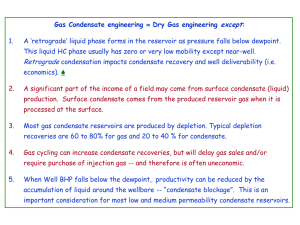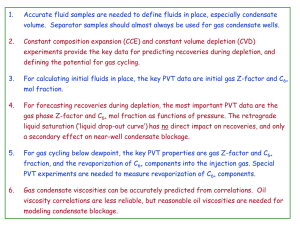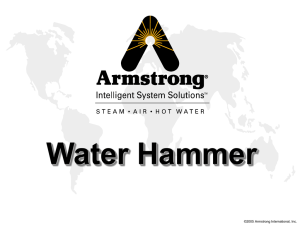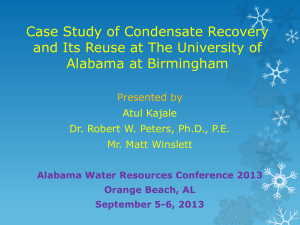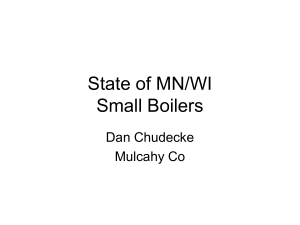热工研究院简介 - ACC Users Group
advertisement
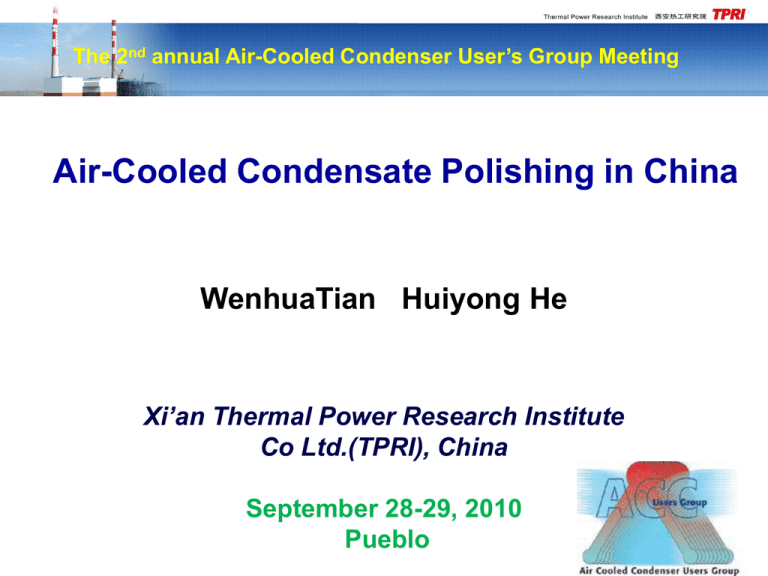
The 2nd annual Air-Cooled Condenser User’s Group Meeting Air-Cooled Condensate Polishing in China WenhuaTian Huiyong He Xi’an Thermal Power Research Institute Co Ltd.(TPRI), China September 28-29, 2010 Pueblo CONTEXTS I. Introduction of TPRI II. Developments of ACCs in China III. Carbon Dioxide in ACCs IV. DO Controlling in ACCs V. Case of Indirect ACCs Introduction of TPRI Developments of ACCs in China Outline The distribution of coal and water resources in China is asymmetric; coal-rich regions typically lack water and vice versa Because of its significant water-saving advantage, ACC is suitable for drought-prone regions in northern China. So the government of China required that all the new built coal power plants should be used ACCs in droughtprone regions after 2002 The use of ACCs has increased rapidly in China within the past five years Development of ACCs The total capacity of ACCs was about 24,000MW by 2007 Number o f units The Capacity(MW) Total Capacity(MW) 23 600 13,800 25 300 7,600 11 200 2,200 percentage of ACCs was 4.3%(Total capacity of coal power plant was 554,000 MW) The number of constructing sub-critical ACC plants was 47, and the capacity was 46,000 MW (2008 ~ 2009) Foreground It is estimated that the total capacity will reach 1,200,000MW until 2015 in China Capacity of coal power plant will be 820,000MW Capacity of ACCs will surpass 100,000MW and occupy 12% Ratio of Direct & Indirect Direct ACCs were the majority, occupied 93% in 2007 Indirect ACCs developed rapidly after 2008. Up to now, the operation capacity is 4,200MW, and other units with 16,800MW capacity is constructing The percentage of different CPP(2009) Ratio of Direct & Indirect Direct ACCs were the majority, occupied 93% in 2007 Indirect ACCs developed rapidly after 2008. Up to now, the operation capacity is 4,200MW, and other units with 16,800MW capacity is constructing Dalater Power Plant ( 4×600MW,Inner Mogolia) Powdered resin filter Datang Tuoketuo Power Plant ( 4×600MW,Inner Mogolia) Unit 5 high-speed cation bed Separated bed in Jingjie power plant (4×600MW,Shaanxi) Carbon Dioxide in ACCs Analyzer method & Instrument Because carbon dioxide in high pure water such as condensate is as low as μg/L(ppb) level , it is difficult to sample and determine. Trace carbon dioxide analyzer(Sentry Co. ) can measure carbon dioxide in high pure water as low as ppb level online. Advantages: (1) convenient and quick testing process (2) high accuracy, good repeatability and high sensitivity Standard: D 4519-94(Reapproved 2005)by ASTM Trace carbon dioxide analyzer(Sentry Co. ) Determination Methods This test method measures the electrical conductivity of high purity water through a cation exchanger in the hydrogen form, then through an electric reboiler. The effluent was boiled at atmospheric boiling water temperature after acidic (volatile) gas removal. subsequently, it was cooled at 25℃. Passage through the cation resin replaces cations (including ammonia and amines)in the water with hydrogen ions. Two conductivity cells located in the instrument provide measurements of the cation conductivity at the incoming sample temperature, and the effluent conductivity at 25℃. In order to obtain the carbon dioxide, subtract the conductivity of pure water (0.055μS/cm) from the conductivity of the final effluent cell. Then deduct this value from the cation conductivity obtained from the cell immediately after the cation exchanger resin. Use this adjusted conductivity value to look up the concentration of volatiles expressed as a concentration of carbon dioxide in Table. Tongchuan Power Plant (2×600MW,Shaanxi Province) Powdex of Tongchuan Power Plant Shangan Power Plant (2×600MW, Hebei Province) CA-AN Bed of Shangan Power Plant Determination Results Type of condensate polishing DO in condensate (μg/L) A Subcritical pressure drum boiler Powdex B Supercritical Oncethrough boiler Prefiltration+ CA -AN bed Plant Type of unit Fe (μg/L) CO2 (μg/L) pH Condensa te Effluent of polishing Feed water 85 30 20 15 15.0 9.4 20 12 3 1 8.0 9.4 Condensate At the same pH condition, the higher level of CO2 , the higher level of Fe in the condensate CO2 recycles in plant A, but it is removed in plant B by separated beds in plant B It is important to control the level of CO2 , it will reduce corrosion of metals in ACCs. DO Controlling in ACCs Determination of DO DO in condense will make iron corroded in ACCs, so the limit DO concentration is 100ppb in China The operational ACCs in condense often surpass the limit of 100ppb Zhaoguang Power Plant (2×300MW+2×600MW, Shanxi Province) Yushe Power Plant (2×300MW,Shanxi Province) Wuxiang Power Plant (2×600MW,Shanxi Province) Hejin Power Plant (2×300MW,Shanxi Province) Determination results of DO Power Plant Capacity Start-up time Hejin Yushe 2×300 2×300 Zhaoguang 2×300 2005 2004.10 2005.7(#1 unit) 2005.9(#2 unit) DO in condensate (μg/L) 70~106 85~237 #1 unit:20~55 #2 unit:52~84 Wuxiang 2×600 2006.10 <30 The reason of high DO in condensate: 1. Vacuum system is too large that will lead to air leakage in ACCs. 2. DO in make-up water is too high. For example, it is 800 ppb in some power plant . Methods to decrease DO Strengthen the welding management and improve its quality, try to decrease the air leakage of vacuum System retrofitting----Case Power Plant Wuxiang Capacity 2×600 MW Start-up time Before the retrofitting the exhaust unit was installed out of the condensed water 2006.10.6 tank, make-up water is supply to external condensed water tank After the retrofitting The condensate tank was combined to the exhaust air cooling device. After through the nozzle, the makeup water goes to the throat of exhaust device. It can lead to an increase of the secondary removal of oxygen in returned condensate. DO in condensate after retrofitting Load Backpressu re (MW) (kPa) Flow of Make up water (t/h) Flow of Condensate DO Condensate Temperature (μg/L) (t/h) (℃) 360 21.0 28.9 760.9 61.2 <0.5 500 23.0 50.7 1045.3 63.2 <0.5 600 20.5 48.2 1269.4 60.7 1.2 600 19.1 18.8 1240.0 60.0 0.7 Case of Indirect ACCs Basic Information Yangcheng Power Plant is located in Shanxi province in China. The first stage project are 6×350MW subcritical WCCs, which was completed at 1997.8. The second stage project are 2×600MW subcritical indirect ACCs named SCAL, which began to construct at 2005.5.18 and completed at 2007.9. The SCAL ACCs is produced by EGI company(Hungary), and it is more like the combination of Harmon’s no tower system and Heller’s cooling tower. Features of SCAL indirect ACCs Cooled water recycles closely during operation, no water consumption High heat -exchange efficiency The corrosion rate of condenser can be controlled by adjusting pH in recycled water in order to prolong service cycle time of condenser Less power consumption The volume of air cooling tower is small Simple system, convenient operation and less capital construction investment CPP Introduction Unit 7 & 8 of Yangcheng Power Plant are indirect ACCs. 3 sets of powdex are used for each CPP. Powdex shows good filtration abillity for crud, but its desalination capacity is weak, so steam quality of the units didn’t reach the standard for most of running time. In order to improve the steam quality, retrofitting of CPP was carried out. 2 high-speed mixed beds were added after powdex The retrofitting has been successfully completed and put into operation in March 2009, and achieved desired results. Steam quality of unit 8 before retrofitting 2007.8-2008.9 Testing Item Unit Standard Value Min. Max. Qualified Rate (%) DO in condensate μg/L 30 10.8 25.1 100 Conductivity in condensate μS/cm 0.3 0.100 0.700 78.0 DO in feed-water μg/L 7 0.1 24.1 92.7 Conductivity in feed water μS/cm 0.2 0.104 1.810 38.0 SiO2 in feed water μg/L 20 3.0 37.8 94.5 Conductivity in boiler water μS/cm 1.5 0.126 2.030 99.7 SiO2 in boiler water μg/L 200 38.6 520 97.6 Conductivity in main steam μS/cm 0.2 0.081 0.657 22.5 SiO2 in main steam μg/L 20 2.9 49 98.0 SiO2, organism, CO2 and other impurities in condensate couldn’t be removed after powdex. It is just depended on boiler blowdown. This is the main reason of high conductivity in steam. Steam quality of unit 8 after retrofitting 2009.3 Testing Item Unit Standar d Value Min. Max. Qualified Rate (%) DO in condensate μg/L 30 10.8 22.4 100 Conductivity in condensate μS/cm 0.3 0.120 0.258 100 DO in feed-water μg/L 7 2.8 6.8 100 Conductivity in feed water μS/cm 0.2 0.104 0.195 100 SiO2 in feed water μg/L 20 5.6 12.5 100 Conductivity in boiler water μS/cm 1.5 0.126 0.256 100 SiO2 in boiler water μg/L 200 58.6 125 100 Conductivity in main steam μS/cm 0.2 0.081 0.159 100 SiO2 in main steam μg/L 20 4.8 12.4 100 After retrofitting, conductivity in the system decreased clearly. The effluent quality of high speed mixed beds is still good after nearly 1 month operation. It achieved the desired results. Thanks for your attention! Welcome to China! Welcome to Xian! Welcome to TPRI! Wenhua Tian:86-029-82102246(Office) 86-13991302260 Email:tianwenhua@tpri.com.cn Huiyong He:86-029-82102570(Office) 86-13609111635 Email:hehuiyong@tpri.com.cn Mixed Bed Cylindrical MB Methods to decrease DO Strengthen the welding management and improve its quality, try to decrease the air leakage of vacuum System retrofitting----Case The condensate tank was combined to the exhaust air cooling device. After through the nozzle, the makeup water goes to the throat of exhaust device. It can lead to an increase of the secondary removal of oxygen in returned condensate.

